Australian Taxation Law Assignment: Income, Deductions and Tax Issues
VerifiedAdded on 2023/06/10
|5
|1393
|366
Homework Assignment
AI Summary
This assignment solution addresses two key issues in Australian taxation law. The first part analyzes Jane's assessable income for the year ending June 30, 2018, considering her salary, TV show earnings, rental income, and insurance compensation, referencing relevant sections of the ITAA 1936 and 1997 and case law. It also identifies deductible expenses like legal fees. The second part examines the deductions BagCo, a resident Australian company, and Brenda, a professional accountant, can claim. BagCo's deductions include expenses related to trading stock, wages, and rental costs. Brenda's deductions encompass equipment costs (using the diminishing value method), conference expenses, and working clothes. The solution refers to relevant sections of the ITAA 1997 and case law like Studebaker Corporation of Australasia Ltd vs C of T and FCT v Hatchett, and provides a detailed breakdown of allowable deductions for both entities.
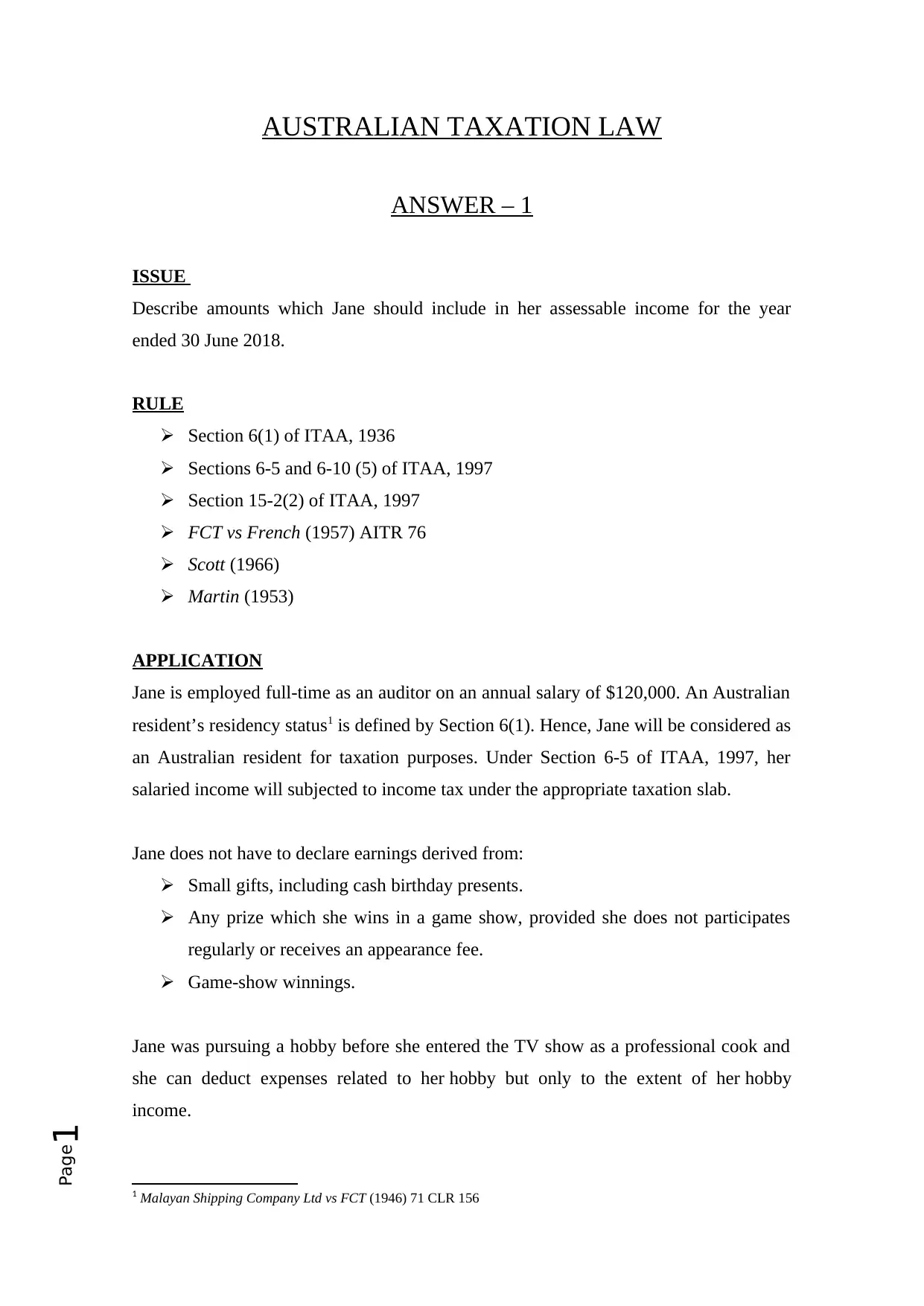
Page1
AUSTRALIAN TAXATION LAW
ANSWER – 1
ISSUE
Describe amounts which Jane should include in her assessable income for the year
ended 30 June 2018.
RULE
Section 6(1) of ITAA, 1936
Sections 6-5 and 6-10 (5) of ITAA, 1997
Section 15-2(2) of ITAA, 1997
FCT vs French (1957) AITR 76
Scott (1966)
Martin (1953)
APPLICATION
Jane is employed full-time as an auditor on an annual salary of $120,000. An Australian
resident’s residency status1 is defined by Section 6(1). Hence, Jane will be considered as
an Australian resident for taxation purposes. Under Section 6-5 of ITAA, 1997, her
salaried income will subjected to income tax under the appropriate taxation slab.
Jane does not have to declare earnings derived from:
Small gifts, including cash birthday presents.
Any prize which she wins in a game show, provided she does not participates
regularly or receives an appearance fee.
Game-show winnings.
Jane was pursuing a hobby before she entered the TV show as a professional cook and
she can deduct expenses related to her hobby but only to the extent of her hobby
income.
1 Malayan Shipping Company Ltd vs FCT (1946) 71 CLR 156
AUSTRALIAN TAXATION LAW
ANSWER – 1
ISSUE
Describe amounts which Jane should include in her assessable income for the year
ended 30 June 2018.
RULE
Section 6(1) of ITAA, 1936
Sections 6-5 and 6-10 (5) of ITAA, 1997
Section 15-2(2) of ITAA, 1997
FCT vs French (1957) AITR 76
Scott (1966)
Martin (1953)
APPLICATION
Jane is employed full-time as an auditor on an annual salary of $120,000. An Australian
resident’s residency status1 is defined by Section 6(1). Hence, Jane will be considered as
an Australian resident for taxation purposes. Under Section 6-5 of ITAA, 1997, her
salaried income will subjected to income tax under the appropriate taxation slab.
Jane does not have to declare earnings derived from:
Small gifts, including cash birthday presents.
Any prize which she wins in a game show, provided she does not participates
regularly or receives an appearance fee.
Game-show winnings.
Jane was pursuing a hobby before she entered the TV show as a professional cook and
she can deduct expenses related to her hobby but only to the extent of her hobby
income.
1 Malayan Shipping Company Ltd vs FCT (1946) 71 CLR 156
Paraphrase This Document
Need a fresh take? Get an instant paraphrase of this document with our AI Paraphraser
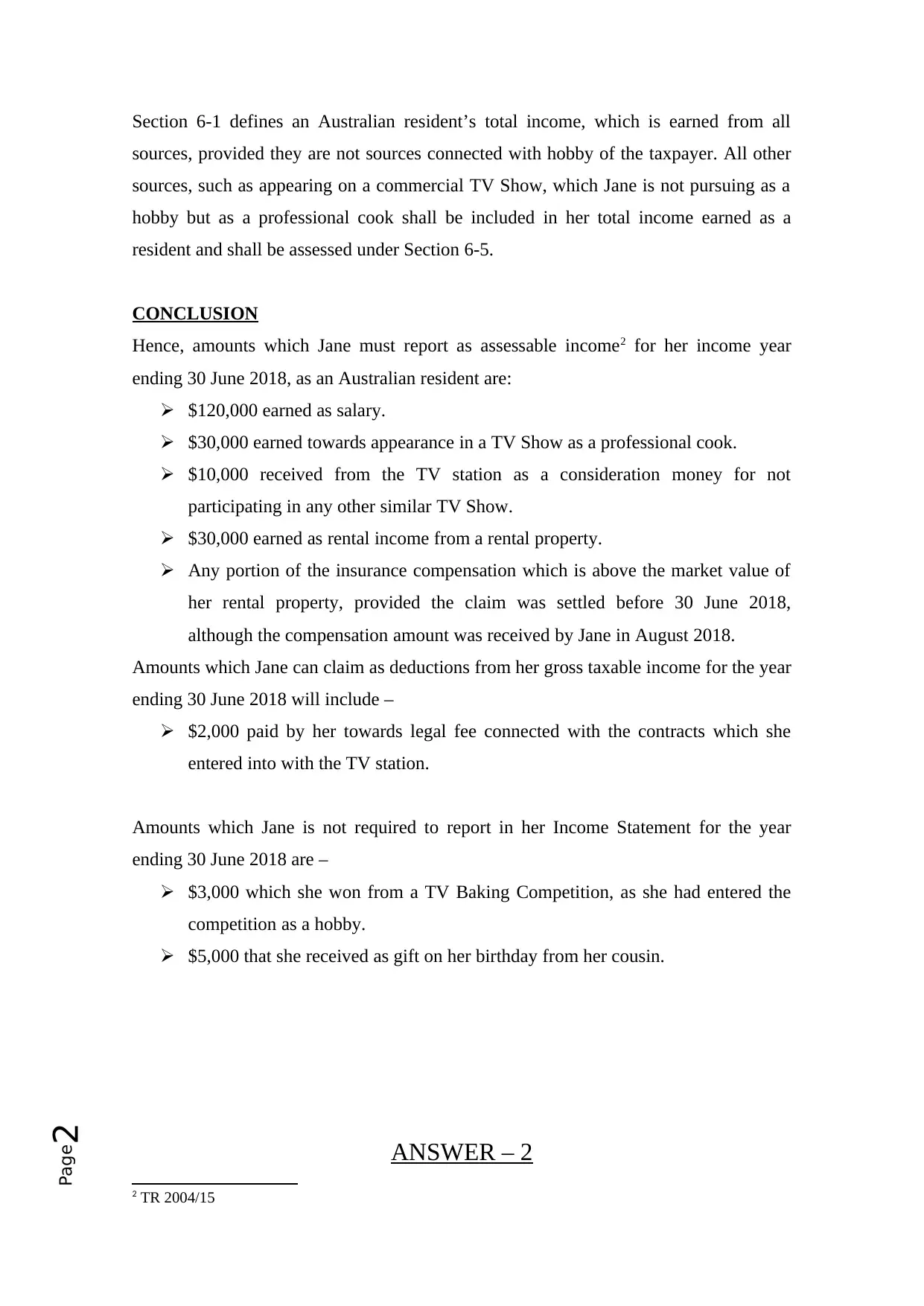
Page2
Section 6-1 defines an Australian resident’s total income, which is earned from all
sources, provided they are not sources connected with hobby of the taxpayer. All other
sources, such as appearing on a commercial TV Show, which Jane is not pursuing as a
hobby but as a professional cook shall be included in her total income earned as a
resident and shall be assessed under Section 6-5.
CONCLUSION
Hence, amounts which Jane must report as assessable income2 for her income year
ending 30 June 2018, as an Australian resident are:
$120,000 earned as salary.
$30,000 earned towards appearance in a TV Show as a professional cook.
$10,000 received from the TV station as a consideration money for not
participating in any other similar TV Show.
$30,000 earned as rental income from a rental property.
Any portion of the insurance compensation which is above the market value of
her rental property, provided the claim was settled before 30 June 2018,
although the compensation amount was received by Jane in August 2018.
Amounts which Jane can claim as deductions from her gross taxable income for the year
ending 30 June 2018 will include –
$2,000 paid by her towards legal fee connected with the contracts which she
entered into with the TV station.
Amounts which Jane is not required to report in her Income Statement for the year
ending 30 June 2018 are –
$3,000 which she won from a TV Baking Competition, as she had entered the
competition as a hobby.
$5,000 that she received as gift on her birthday from her cousin.
ANSWER – 2
2 TR 2004/15
Section 6-1 defines an Australian resident’s total income, which is earned from all
sources, provided they are not sources connected with hobby of the taxpayer. All other
sources, such as appearing on a commercial TV Show, which Jane is not pursuing as a
hobby but as a professional cook shall be included in her total income earned as a
resident and shall be assessed under Section 6-5.
CONCLUSION
Hence, amounts which Jane must report as assessable income2 for her income year
ending 30 June 2018, as an Australian resident are:
$120,000 earned as salary.
$30,000 earned towards appearance in a TV Show as a professional cook.
$10,000 received from the TV station as a consideration money for not
participating in any other similar TV Show.
$30,000 earned as rental income from a rental property.
Any portion of the insurance compensation which is above the market value of
her rental property, provided the claim was settled before 30 June 2018,
although the compensation amount was received by Jane in August 2018.
Amounts which Jane can claim as deductions from her gross taxable income for the year
ending 30 June 2018 will include –
$2,000 paid by her towards legal fee connected with the contracts which she
entered into with the TV station.
Amounts which Jane is not required to report in her Income Statement for the year
ending 30 June 2018 are –
$3,000 which she won from a TV Baking Competition, as she had entered the
competition as a hobby.
$5,000 that she received as gift on her birthday from her cousin.
ANSWER – 2
2 TR 2004/15
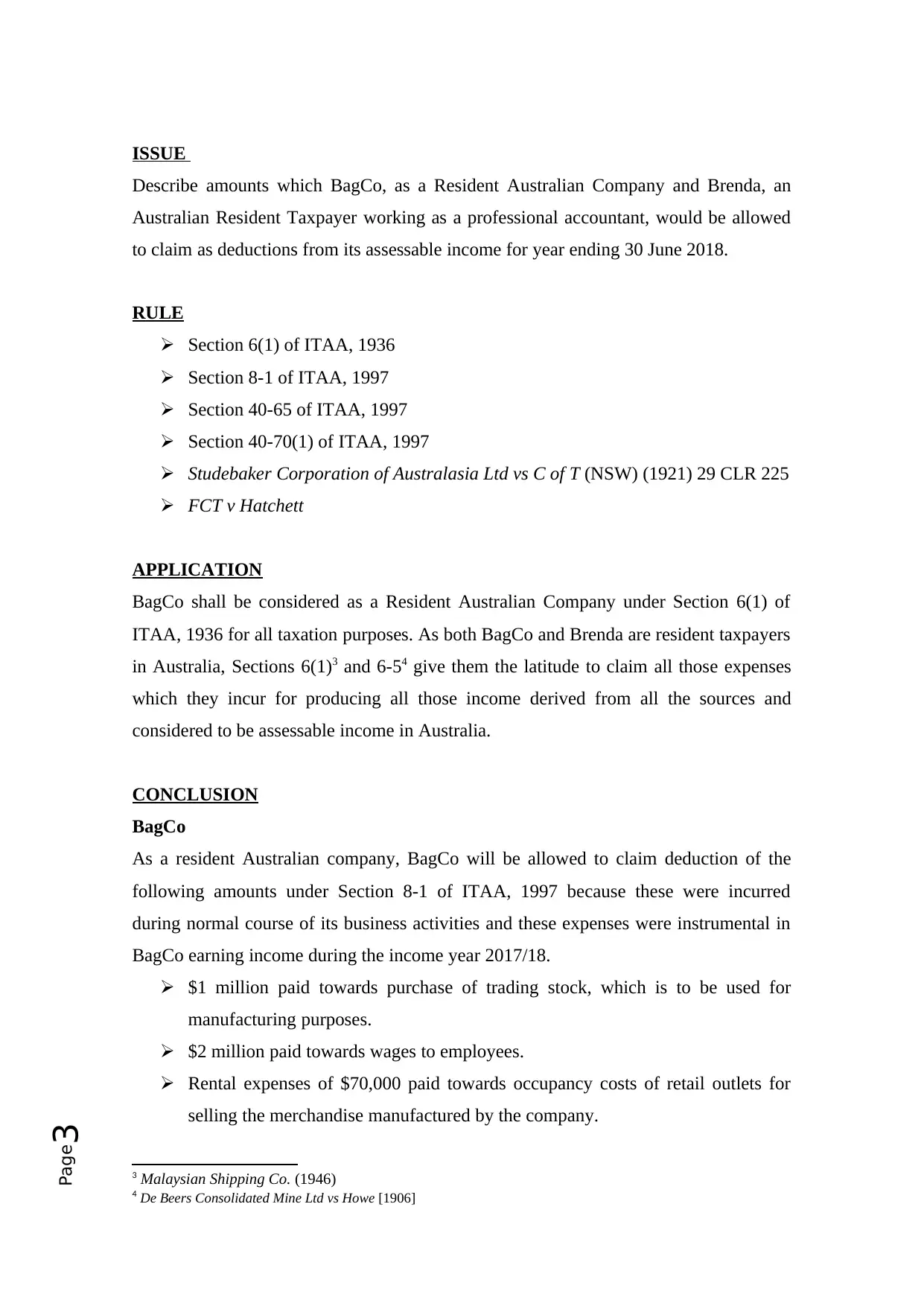
Page3
ISSUE
Describe amounts which BagCo, as a Resident Australian Company and Brenda, an
Australian Resident Taxpayer working as a professional accountant, would be allowed
to claim as deductions from its assessable income for year ending 30 June 2018.
RULE
Section 6(1) of ITAA, 1936
Section 8-1 of ITAA, 1997
Section 40-65 of ITAA, 1997
Section 40-70(1) of ITAA, 1997
Studebaker Corporation of Australasia Ltd vs C of T (NSW) (1921) 29 CLR 225
FCT v Hatchett
APPLICATION
BagCo shall be considered as a Resident Australian Company under Section 6(1) of
ITAA, 1936 for all taxation purposes. As both BagCo and Brenda are resident taxpayers
in Australia, Sections 6(1)3 and 6-54 give them the latitude to claim all those expenses
which they incur for producing all those income derived from all the sources and
considered to be assessable income in Australia.
CONCLUSION
BagCo
As a resident Australian company, BagCo will be allowed to claim deduction of the
following amounts under Section 8-1 of ITAA, 1997 because these were incurred
during normal course of its business activities and these expenses were instrumental in
BagCo earning income during the income year 2017/18.
$1 million paid towards purchase of trading stock, which is to be used for
manufacturing purposes.
$2 million paid towards wages to employees.
Rental expenses of $70,000 paid towards occupancy costs of retail outlets for
selling the merchandise manufactured by the company.
3 Malaysian Shipping Co. (1946)
4 De Beers Consolidated Mine Ltd vs Howe [1906]
ISSUE
Describe amounts which BagCo, as a Resident Australian Company and Brenda, an
Australian Resident Taxpayer working as a professional accountant, would be allowed
to claim as deductions from its assessable income for year ending 30 June 2018.
RULE
Section 6(1) of ITAA, 1936
Section 8-1 of ITAA, 1997
Section 40-65 of ITAA, 1997
Section 40-70(1) of ITAA, 1997
Studebaker Corporation of Australasia Ltd vs C of T (NSW) (1921) 29 CLR 225
FCT v Hatchett
APPLICATION
BagCo shall be considered as a Resident Australian Company under Section 6(1) of
ITAA, 1936 for all taxation purposes. As both BagCo and Brenda are resident taxpayers
in Australia, Sections 6(1)3 and 6-54 give them the latitude to claim all those expenses
which they incur for producing all those income derived from all the sources and
considered to be assessable income in Australia.
CONCLUSION
BagCo
As a resident Australian company, BagCo will be allowed to claim deduction of the
following amounts under Section 8-1 of ITAA, 1997 because these were incurred
during normal course of its business activities and these expenses were instrumental in
BagCo earning income during the income year 2017/18.
$1 million paid towards purchase of trading stock, which is to be used for
manufacturing purposes.
$2 million paid towards wages to employees.
Rental expenses of $70,000 paid towards occupancy costs of retail outlets for
selling the merchandise manufactured by the company.
3 Malaysian Shipping Co. (1946)
4 De Beers Consolidated Mine Ltd vs Howe [1906]
⊘ This is a preview!⊘
Do you want full access?
Subscribe today to unlock all pages.

Trusted by 1+ million students worldwide
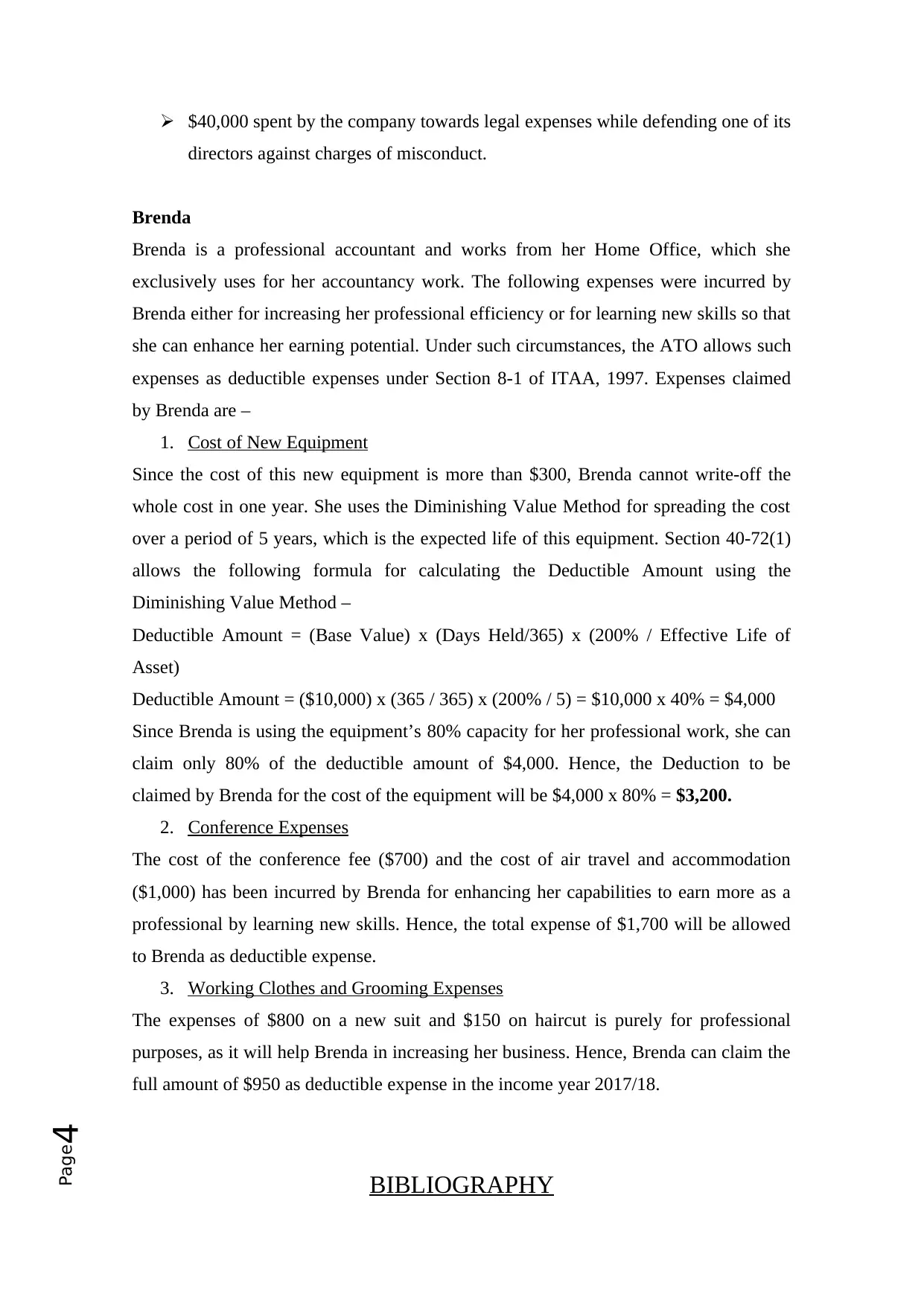
Page4
$40,000 spent by the company towards legal expenses while defending one of its
directors against charges of misconduct.
Brenda
Brenda is a professional accountant and works from her Home Office, which she
exclusively uses for her accountancy work. The following expenses were incurred by
Brenda either for increasing her professional efficiency or for learning new skills so that
she can enhance her earning potential. Under such circumstances, the ATO allows such
expenses as deductible expenses under Section 8-1 of ITAA, 1997. Expenses claimed
by Brenda are –
1. Cost of New Equipment
Since the cost of this new equipment is more than $300, Brenda cannot write-off the
whole cost in one year. She uses the Diminishing Value Method for spreading the cost
over a period of 5 years, which is the expected life of this equipment. Section 40-72(1)
allows the following formula for calculating the Deductible Amount using the
Diminishing Value Method –
Deductible Amount = (Base Value) x (Days Held/365) x (200% / Effective Life of
Asset)
Deductible Amount = ($10,000) x (365 / 365) x (200% / 5) = $10,000 x 40% = $4,000
Since Brenda is using the equipment’s 80% capacity for her professional work, she can
claim only 80% of the deductible amount of $4,000. Hence, the Deduction to be
claimed by Brenda for the cost of the equipment will be $4,000 x 80% = $3,200.
2. Conference Expenses
The cost of the conference fee ($700) and the cost of air travel and accommodation
($1,000) has been incurred by Brenda for enhancing her capabilities to earn more as a
professional by learning new skills. Hence, the total expense of $1,700 will be allowed
to Brenda as deductible expense.
3. Working Clothes and Grooming Expenses
The expenses of $800 on a new suit and $150 on haircut is purely for professional
purposes, as it will help Brenda in increasing her business. Hence, Brenda can claim the
full amount of $950 as deductible expense in the income year 2017/18.
BIBLIOGRAPHY
$40,000 spent by the company towards legal expenses while defending one of its
directors against charges of misconduct.
Brenda
Brenda is a professional accountant and works from her Home Office, which she
exclusively uses for her accountancy work. The following expenses were incurred by
Brenda either for increasing her professional efficiency or for learning new skills so that
she can enhance her earning potential. Under such circumstances, the ATO allows such
expenses as deductible expenses under Section 8-1 of ITAA, 1997. Expenses claimed
by Brenda are –
1. Cost of New Equipment
Since the cost of this new equipment is more than $300, Brenda cannot write-off the
whole cost in one year. She uses the Diminishing Value Method for spreading the cost
over a period of 5 years, which is the expected life of this equipment. Section 40-72(1)
allows the following formula for calculating the Deductible Amount using the
Diminishing Value Method –
Deductible Amount = (Base Value) x (Days Held/365) x (200% / Effective Life of
Asset)
Deductible Amount = ($10,000) x (365 / 365) x (200% / 5) = $10,000 x 40% = $4,000
Since Brenda is using the equipment’s 80% capacity for her professional work, she can
claim only 80% of the deductible amount of $4,000. Hence, the Deduction to be
claimed by Brenda for the cost of the equipment will be $4,000 x 80% = $3,200.
2. Conference Expenses
The cost of the conference fee ($700) and the cost of air travel and accommodation
($1,000) has been incurred by Brenda for enhancing her capabilities to earn more as a
professional by learning new skills. Hence, the total expense of $1,700 will be allowed
to Brenda as deductible expense.
3. Working Clothes and Grooming Expenses
The expenses of $800 on a new suit and $150 on haircut is purely for professional
purposes, as it will help Brenda in increasing her business. Hence, Brenda can claim the
full amount of $950 as deductible expense in the income year 2017/18.
BIBLIOGRAPHY
Paraphrase This Document
Need a fresh take? Get an instant paraphrase of this document with our AI Paraphraser
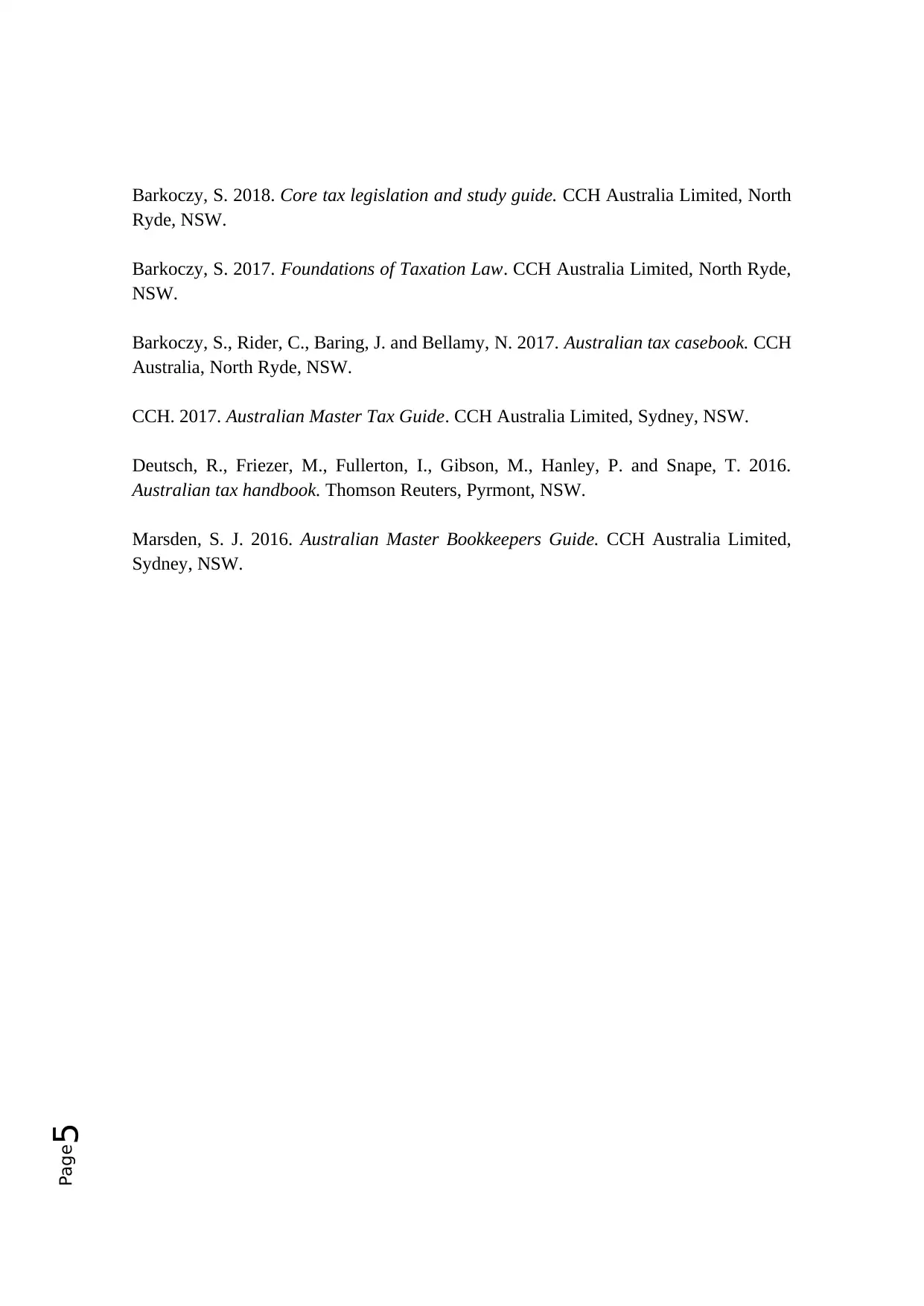
Page5
Barkoczy, S. 2018. Core tax legislation and study guide. CCH Australia Limited, North
Ryde, NSW.
Barkoczy, S. 2017. Foundations of Taxation Law. CCH Australia Limited, North Ryde,
NSW.
Barkoczy, S., Rider, C., Baring, J. and Bellamy, N. 2017. Australian tax casebook. CCH
Australia, North Ryde, NSW.
CCH. 2017. Australian Master Tax Guide. CCH Australia Limited, Sydney, NSW.
Deutsch, R., Friezer, M., Fullerton, I., Gibson, M., Hanley, P. and Snape, T. 2016.
Australian tax handbook. Thomson Reuters, Pyrmont, NSW.
Marsden, S. J. 2016. Australian Master Bookkeepers Guide. CCH Australia Limited,
Sydney, NSW.
Barkoczy, S. 2018. Core tax legislation and study guide. CCH Australia Limited, North
Ryde, NSW.
Barkoczy, S. 2017. Foundations of Taxation Law. CCH Australia Limited, North Ryde,
NSW.
Barkoczy, S., Rider, C., Baring, J. and Bellamy, N. 2017. Australian tax casebook. CCH
Australia, North Ryde, NSW.
CCH. 2017. Australian Master Tax Guide. CCH Australia Limited, Sydney, NSW.
Deutsch, R., Friezer, M., Fullerton, I., Gibson, M., Hanley, P. and Snape, T. 2016.
Australian tax handbook. Thomson Reuters, Pyrmont, NSW.
Marsden, S. J. 2016. Australian Master Bookkeepers Guide. CCH Australia Limited,
Sydney, NSW.
1 out of 5
Related Documents
Your All-in-One AI-Powered Toolkit for Academic Success.
+13062052269
info@desklib.com
Available 24*7 on WhatsApp / Email
![[object Object]](/_next/static/media/star-bottom.7253800d.svg)
Unlock your academic potential
Copyright © 2020–2025 A2Z Services. All Rights Reserved. Developed and managed by ZUCOL.





